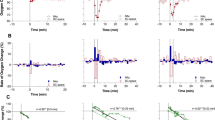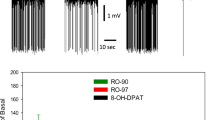Abstract
THERE is considerable evidence that the ascending cate-cholaminergic systems of the brain1 are involved with behaviour that is contingent on reward. Much of this evidence concerns the variables which influence intracranial self-stimulation behaviour2. Because the anatomical and neurochemical correlates of self-stimulation are specified, evaluation of the catecholamine hypothesis should ideally involve the manipulation or measurement of neurochemical activity within restricted regions of the brain. We have made a first step in determining the neurochemical code of the excitatory input to the dopaminergic systems which originate in the ventral mesencephalon (VM) and which are thought to play a part in intracranial self-stimulation3. A technique well suited for this purpose is push–pull perfusion with which exogenous putative neuro-transmitters can be administered to discrete regions of the brain by way of the perfusion medium. Using this technique it was possible to establish dose–response relationships between self-stimulation of the medial forebrain bundle (MFB), through which fibres of the catecholaminergic systems pass, and perfusion of 5-hydroxytryptamine (5-HT) or acetylcholine (ACh) in the VM.
This is a preview of subscription content, access via your institution
Access options
Subscribe to this journal
Receive 51 print issues and online access
$199.00 per year
only $3.90 per issue
Buy this article
- Purchase on Springer Link
- Instant access to full article PDF
Prices may be subject to local taxes which are calculated during checkout
Similar content being viewed by others
References
Ungerstedt, U., Acta physiol. scand., 82, suppl. 367, 1–48 (1971).
German, D. C., and Bowden, D. M., Brain Res., 73, 381–419 (1974).
Crow, T. J., Brain Res., 36, 265–273 (1972).
Pelligrino, L. J., and Cushman, A. J., A Stereotaxic Atlas of the Rat Brain (Appleton-Century-Crofts, New York, 1967).
Chase, T. N., and Kopin, I. J., Nature, 217, 466–467 (1968).
Myers, R. D., in Methods in Psychobiology, 2 (edit. by Myers, R. D.), 169–211 (Academic, London and New York, 1971).
Wolf, G., in Methods in Psychobiology, 1 (edit. by Myers, R. D.), 281–300 (Academic, London and New York, 1971).
Siegel, S., Nonparametric Statistics for the Behavioural Sciences, 184–193 (McGraw-Hill, New York, 1956).
Wise, C. D., Berger, B. D., and Stein, L., Biol. Psychiat., 6, 3–21 (1973).
Poschel, B. P. H., Ninteman, F. W., McLean, J. R., and Potoczak, D., Life Sci., 15, 1515–1522 (1974).
Ungerstedt, U., and Arbuthnott, G., Brain Res., 241, 485–493 (1970).
Simon, H., and Le Moal, M., Expl Brain Res., 23 (suppl.) 190 (1975).
Miliaressis, E., Bouchard, A., and Jacobowitz, D. M., Brain Res., 98, 144–201 (1975).
Butcher, L. L., Talbot, K., and Bilezikjian, L., Proc. West. pharmac. Soc., 18, 256–259 (1975).
Author information
Authors and Affiliations
Rights and permissions
About this article
Cite this article
REDGRAVE, P., IAN HORRELL, R. Potentiation of central reward by localised perfusion of acetylcholine and 5-hydroxytryptamine. Nature 262, 305–307 (1976). https://doi.org/10.1038/262305a0
Received:
Accepted:
Published:
Issue Date:
DOI: https://doi.org/10.1038/262305a0
This article is cited by
-
Dorsal raphe serotonin neurons inhibit operant responding for reward via inputs to the ventral tegmental area but not the nucleus accumbens: evidence from studies combining optogenetic stimulation and serotonin reuptake inhibition
Neuropsychopharmacology (2019)
-
The Cholinergic System as a Treatment Target for Opioid Use Disorder
CNS Drugs (2018)
-
A glutamatergic reward input from the dorsal raphe to ventral tegmental area dopamine neurons
Nature Communications (2014)
-
Effects of systemic and intra-nucleus accumbens 5-HT2C receptor compounds on ventral tegmental area self-stimulation thresholds in rats
Psychopharmacology (2009)
-
The Role of Acetylcholine in Cocaine Addiction
Neuropsychopharmacology (2008)
Comments
By submitting a comment you agree to abide by our Terms and Community Guidelines. If you find something abusive or that does not comply with our terms or guidelines please flag it as inappropriate.



